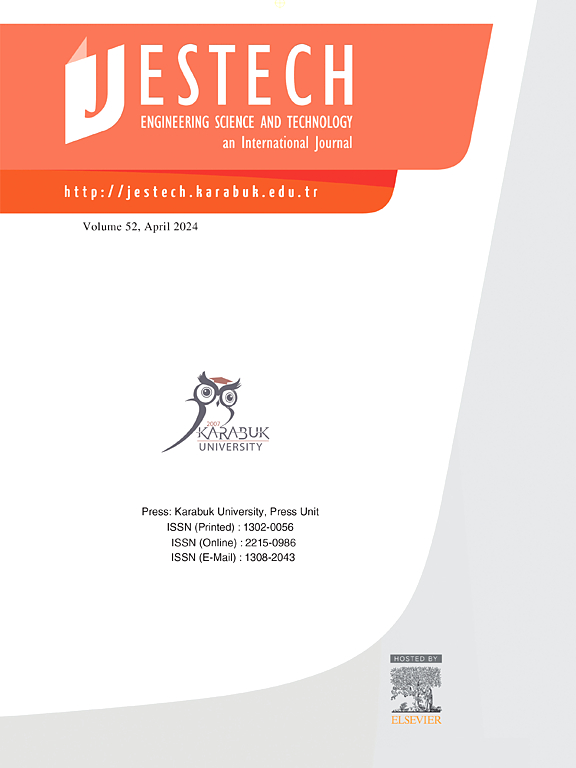Towards enhanced photovoltaic Modeling: New single diode Model variants with nonlinear ideality factor dependence
IF 5.4
2区 工程技术
Q1 ENGINEERING, MULTIDISCIPLINARY
Engineering Science and Technology-An International Journal-Jestech
Pub Date : 2025-03-19
DOI:10.1016/j.jestch.2025.102037
引用次数: 0
Abstract
The energy sector is increasingly challenged to transition to sustainable and renewable energy sources. Solar cells play a pivotal role in this process, enabling the direct conversion of solar energy into electricity. Traditional solar cell models, such as the single-diode model (SDM), often assume a constant diode ideality factor, despite research indicating its dependence on voltage. This study introduces five novel SDM variants that incorporate the nonlinear dependence of the diode ideality factor on voltage, aiming to improve the accuracy of current–voltage (I-V) characteristic modeling. For each of the proposed models, an analytical current–voltage relationship was derived using the Lambert W function, ensuring precise representation of the system’s behavior. Experimental validation was conducted on a standard solar cell (RTC France) and three commercial modules (MSX60, PWP201, KC200GT), demonstrating significant reductions in modeling errors (RMSE) compared to classical SDM, DDM, and TDM approaches. Furthermore, the analysis highlights the stable performance of the proposed models under varying conditions of insolation and temperature, confirming their robustness and practical applicability. This work provides an innovative framework for enhancing solar cell modeling, laying the foundation for future research and practical applications in optimizing photovoltaic systems.
面向增强的光伏建模:具有非线性理想因子依赖的新型单二极管模型变体
能源部门在向可持续和可再生能源过渡方面面临越来越大的挑战。太阳能电池在这一过程中起着关键作用,使太阳能直接转化为电能。传统的太阳能电池模型,如单二极管模型(SDM),通常假设一个恒定的二极管理想因数,尽管研究表明其依赖于电压。本研究引入了五种新的SDM变体,这些变体结合了二极管理想因数对电压的非线性依赖,旨在提高电流-电压(I-V)特性建模的准确性。对于每个提出的模型,使用Lambert W函数推导出解析的电流-电压关系,确保系统行为的精确表示。在标准太阳能电池(RTC France)和三种商用模块(MSX60、PWP201、KC200GT)上进行了实验验证,结果表明,与传统的SDM、DDM和TDM方法相比,建模误差(RMSE)显著降低。此外,分析强调了所提出的模型在不同日照和温度条件下的稳定性能,证实了其鲁棒性和实用性。这项工作为加强太阳能电池建模提供了一个创新的框架,为优化光伏系统的未来研究和实际应用奠定了基础。
本文章由计算机程序翻译,如有差异,请以英文原文为准。
求助全文
约1分钟内获得全文
求助全文
来源期刊

Engineering Science and Technology-An International Journal-Jestech
Materials Science-Electronic, Optical and Magnetic Materials
CiteScore
11.20
自引率
3.50%
发文量
153
审稿时长
22 days
期刊介绍:
Engineering Science and Technology, an International Journal (JESTECH) (formerly Technology), a peer-reviewed quarterly engineering journal, publishes both theoretical and experimental high quality papers of permanent interest, not previously published in journals, in the field of engineering and applied science which aims to promote the theory and practice of technology and engineering. In addition to peer-reviewed original research papers, the Editorial Board welcomes original research reports, state-of-the-art reviews and communications in the broadly defined field of engineering science and technology.
The scope of JESTECH includes a wide spectrum of subjects including:
-Electrical/Electronics and Computer Engineering (Biomedical Engineering and Instrumentation; Coding, Cryptography, and Information Protection; Communications, Networks, Mobile Computing and Distributed Systems; Compilers and Operating Systems; Computer Architecture, Parallel Processing, and Dependability; Computer Vision and Robotics; Control Theory; Electromagnetic Waves, Microwave Techniques and Antennas; Embedded Systems; Integrated Circuits, VLSI Design, Testing, and CAD; Microelectromechanical Systems; Microelectronics, and Electronic Devices and Circuits; Power, Energy and Energy Conversion Systems; Signal, Image, and Speech Processing)
-Mechanical and Civil Engineering (Automotive Technologies; Biomechanics; Construction Materials; Design and Manufacturing; Dynamics and Control; Energy Generation, Utilization, Conversion, and Storage; Fluid Mechanics and Hydraulics; Heat and Mass Transfer; Micro-Nano Sciences; Renewable and Sustainable Energy Technologies; Robotics and Mechatronics; Solid Mechanics and Structure; Thermal Sciences)
-Metallurgical and Materials Engineering (Advanced Materials Science; Biomaterials; Ceramic and Inorgnanic Materials; Electronic-Magnetic Materials; Energy and Environment; Materials Characterizastion; Metallurgy; Polymers and Nanocomposites)
 求助内容:
求助内容: 应助结果提醒方式:
应助结果提醒方式:


